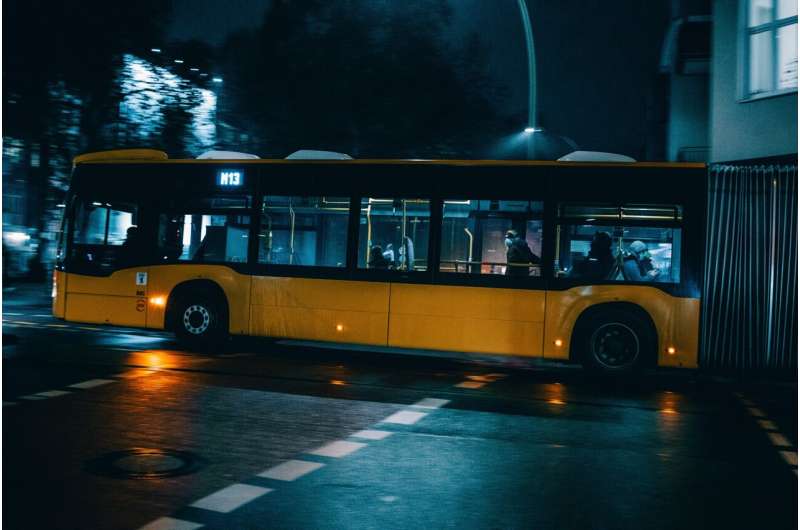This article has been reviewed according to Science X's editorial process and policies. Editors have highlighted the following attributes while ensuring the content's credibility:
fact-checked
peer-reviewed publication
proofread
Promoting public transportation with modern pricing schemes

In Summer 2022, Germany introduced an unprecedented reduction in public transport fares, the so-called 9-Euro Ticket, which granted nationwide access to public transport for just 9 Euros per month—recently followed up by the "DeutschlandTicket" program for 49 Euros per month. An analysis by RWI–Leibniz Institute for Economic Research and Yale University shows that the 9-Euro Ticket had little impact on car use.
In a recent article published in the journal Nature, the researchers argue for the introduction of a subsidized but dynamic public transport tariff in combination with dynamic road pricing.
Compared to a subsidized, flat monthly ticket—such as the DeutschlandTicket or similar programs in other countries—this policy could significantly promote the switch from car to public transport. The researchers base this proposal on their study of the effects of the 9-Euro Ticket, published as RWI Position #82 "Promoting Public Transport with Modern Pricing Schemes."
Key points of the study are:
- The evaluation by RWI and Yale University shows only slight decreases in weekly car mileage during the 9-Euro Ticket's availability, corresponding to a reduction of about 10%.
- From a climate change mitigation perspective, the measure was associated with high short-term CO2 abatement costs due to the high total expenditure of €2.5 billion, far exceeding the costs of common climate protection measures.
- The 9-Euro Ticket led to an increase in the use of public transportation that was almost twice as large as the decrease in car use. This increased demand for public transport exacerbated overcrowding on buses and trains at peak times.
- The study authors use a difference-in-differences approach, that is, a comparison of changes in mobility behavior using data from two large-scale surveys based on a representative household panel. The surveys were conducted in April and June 2022, i.e., before and during the availability of the 9-Euro Ticket.
Based on the findings listed above, experiences with similar programs in other European cities and insights from economic theory, the researchers argue for a twofold system that interlinks driving and public transport. This system includes dynamic tariffs for public transport with particularly low prices outside peak hours. The subsidy required for such a pricing system would be provided, at least in part, through dynamic road prices.
These charges could be levied by means of digital solutions, which have already been tested in other countries, and their amount would depend on the current utilization of the road network. When combined, these measures would create incentives to switch from cars to public transport and provide optimal incentives for a more balanced utilization of public transport and roads.
"The pricing system we propose is not more expensive for public transport users. For example, the prices in peak times could be the same as today's prices, and in times of empty buses and trains they would fall to a very low price, potentially even zero," states mobility expert Mark Andor (RWI), principal investigator of the study.
"Flat-rate tickets have—despite their simplicity—a crucial disadvantage: they lack the potential for price-based demand management," explains Fabian Dehos (RWI). "Let's implement an incentive compatible flexible pricing system that ensures optimal utilization of buses and trains, preventing them from operating empty."
"If, for political reasons, the 49-Euro Ticket is to be retained, dynamic prices could also be introduced to complement the DeutschlandTicket," says Sven Hansteen (RWI). "In such a case, the dynamic prices would not apply to subscribers, but offer optimal fares to any other potential customers. The large proportion of the population that does not subscribe to the DeutschlandTicket could thus benefit from the dynamic prices and especially from the low prices in off-peak hours."
"The experience with the German 9-Euro Ticket and with comparable measures underline that it takes more than just lowering public transport prices to change travel behavior away from cars on a large scale," adds Lukas Tomberg (RWI). "Therefore, we suggest coupling subsidized public transport fares with dynamic road pricing to create a direct incentive to also use roads optimally, i.e., to drive less, especially during peak hours. However, if dynamic road pricing is still deemed unsuitable for political reasons, dynamic public transport fares could still be introduced on their own."
"Finally," says Kenneth Gillingham of Yale University, "it is important to note that we propose a pricing system that could apply more broadly to any country that is aiming to refine the design of their transport system, not just Germany. A consistent application of the proposed policy has the potential to lead to significantly lower local and global air pollutant emissions, less congestion, fewer accidents, quieter cities, and ultimately a better quality of life."
More information: Mark A. Andor et al, Germany: luring drivers onto public transport, Nature (2023). DOI: 10.1038/d41586-023-02034-5
Journal information: Nature
Provided by Leibniz-Institut für Wirtschaftsforschung




















